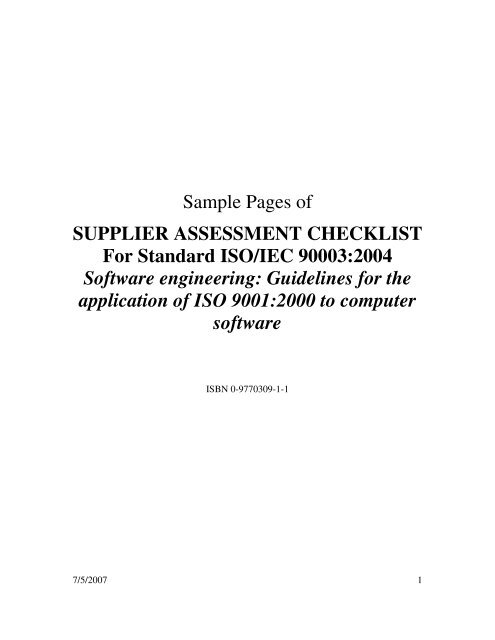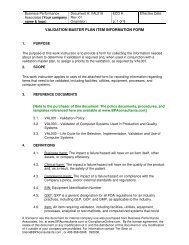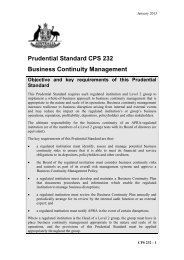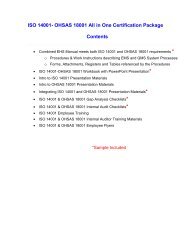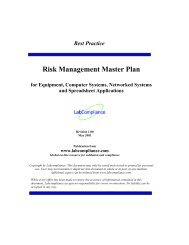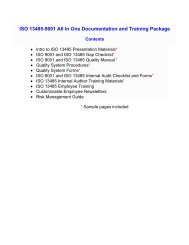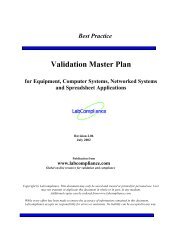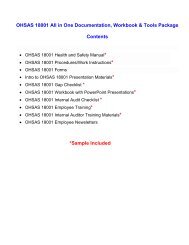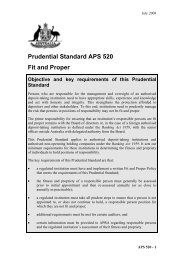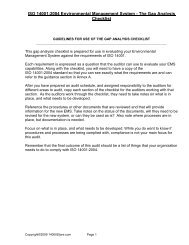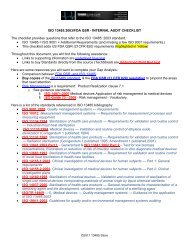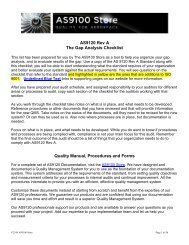Sample Pages of SUPPLIER ASSESSMENT CHECKLIST For ...
Sample Pages of SUPPLIER ASSESSMENT CHECKLIST For ...
Sample Pages of SUPPLIER ASSESSMENT CHECKLIST For ...
- No tags were found...
You also want an ePaper? Increase the reach of your titles
YUMPU automatically turns print PDFs into web optimized ePapers that Google loves.
<strong>Sample</strong> <strong>Pages</strong> <strong>of</strong><br />
<strong>SUPPLIER</strong> <strong>ASSESSMENT</strong> <strong>CHECKLIST</strong><br />
<strong>For</strong> Standard ISO/IEC 90003:2004<br />
S<strong>of</strong>tware engineering: Guidelines for the<br />
application <strong>of</strong> ISO 9001:2000 to computer<br />
s<strong>of</strong>tware<br />
ISBN 0-9770309-1-1<br />
7/5/2007 1
<strong>Sample</strong> <strong>Pages</strong> <strong>of</strong><br />
<strong>SUPPLIER</strong> <strong>ASSESSMENT</strong> <strong>CHECKLIST</strong><br />
<strong>For</strong> Standard ISO/IEC 90003:2004<br />
S<strong>of</strong>tware engineering: Guidelines for the<br />
application <strong>of</strong> ISO 9001:2000 to computer<br />
s<strong>of</strong>tware<br />
ISBN 0-9770309-1-1<br />
Author: Andy Coster, CCP<br />
Produced by<br />
S<strong>of</strong>tware Engineering Process Technology<br />
(SEPT)<br />
2725 NW Pine Cone Drive<br />
Issaquah, WA. 98027<br />
Tel. 425-391-2344<br />
E-mail: Stanmagee@COMPUSERVE.COM<br />
Web Site: www.12207.com<br />
© 2006. S<strong>of</strong>tware Engineering Process Technology (SEPT) All rights reserved.<br />
7/5/2007 2
Standard ISO/IEC 90003:2004 –<br />
Supplier Assessment Checklist<br />
Section 1<br />
Background<br />
Many companies have asked SEPT- “Do you have a checklist to use with our s<strong>of</strong>tware<br />
suppliers to determine if they meet the requirements <strong>of</strong> Standard ISO/IEC<br />
90003:2004”? These vendors stated they wanted a checklist that contained only basic<br />
requirements and no suggested artifacts. After determining our customer’s needs SEPT<br />
has developed this checklist to meet that requirement. SEPT also produces a checklist for<br />
internal use within an organization to determine compliance with ISO/IEC 90003:2004.<br />
These two checklists are designed to be used as companion documents:<br />
1. The Evidence Product checklist – to be used internally within an organization<br />
2. The Supplier Assessment checklist to be used for supplier qualification and in<br />
supplier audits and reviews.<br />
Introduction<br />
The purpose <strong>of</strong> this document (Checklist) is to assist a company to determine if their<br />
“s<strong>of</strong>tware” supplier(s) meet the requirements <strong>of</strong> Standard ISO/IEC 90003:2004 S<strong>of</strong>tware<br />
engineering: Guidelines for the application <strong>of</strong> ISO 9001:2000 to computer s<strong>of</strong>tware. This<br />
document is designed to be used to:<br />
• determine if a potential supplier has in place the key s<strong>of</strong>tware process<br />
(artifacts), or<br />
• qualify a supplier as approved for use, or<br />
• provide a checklist for audit or review <strong>of</strong> a supplier.<br />
The steps we used to develop this document are very similar to the ones used to produce<br />
the base line evidence product document.<br />
The process <strong>of</strong> defining what is necessary for compliance with a quality management<br />
process standard such as “ISO/IEC 90003:2004” is <strong>of</strong>ten confusing and laborious because<br />
the directions contained in the standards are unclear or ambiguous. To aid in determining<br />
what is actually “required” by the document in the way <strong>of</strong> physical evidence <strong>of</strong><br />
compliance, the experts at SEPT have produced this checklist. All our checklists are<br />
constructed around a classification scheme <strong>of</strong> physical evidence comprised <strong>of</strong> policies,<br />
procedures, plans, records, documents, audits, and reviews. There must be an<br />
accompanying record <strong>of</strong> some type when an audit or review has been accomplished. This<br />
record would define the findings <strong>of</strong> the review or audit and any corrective action to be<br />
taken. <strong>For</strong> the sake <strong>of</strong> brevity this checklist does not call out a separate record for each<br />
review or audit. In these checklists, “manuals, reports, scripts and specifications” are<br />
included in the document category. When the subject standard references another<br />
standard for physical evidence, the checklist does not call out the full requirements <strong>of</strong> the<br />
referenced standard, only the expected physical evidence that should be available.<br />
7/5/2007 3
The author has carefully reviewed the document “ISO/IEC 90003:2004 S<strong>of</strong>tware<br />
Engineering: Guidelines for the application <strong>of</strong> ISO 9001:2000 to computer s<strong>of</strong>tware " and<br />
defined the physical evidence required based upon this classification scheme. If a<br />
document is called out more than one time, only the first reference is stipulated.<br />
Additionally, there are many references to ISO/IEC 12207 in ISO/IEC 90003:2004 so<br />
ISO/IEC 12207 required items have been included and are denoted by a (#).<br />
There are occasional situations in which a procedure or document is not necessarily<br />
separate and could be contained within another document. <strong>For</strong> example, the "Design and<br />
Development Verification Procedure" could be a part <strong>of</strong> the "Design and Development<br />
Procedure". The author has called out these individual items separately to ensure that the<br />
organization does not overlook any facet <strong>of</strong> physical evidence. If the organization does<br />
not require a separate document, and an item can be a subset <strong>of</strong> another document or<br />
record, then this fact should be denoted in the detail section <strong>of</strong> the checklist for that item.<br />
This should be done in the form <strong>of</strong> a statement reflecting that the information for this<br />
document may be found in section XX <strong>of</strong> Document XYZ. If the organizational<br />
requirements do not call for this physical evidence for a particular item, this should also<br />
be denoted with a statement reflecting that this physical evidence is not required and why.<br />
The reasons for the evidence not being required should be clearly presented in this<br />
statement. Further details on this step are provided in the Detail Steps section <strong>of</strong> the<br />
introduction. The size <strong>of</strong> these documents could vary from paragraphs to volumes<br />
depending upon the size and complexity <strong>of</strong> the project or business requirements.<br />
General Principles <strong>of</strong> the Standard ISO/IEC 90003:2004 S<strong>of</strong>tware engineering –<br />
Guidelines for the application <strong>of</strong> ISO 9001:2000 to computer s<strong>of</strong>tware -<br />
Requirements Checklist<br />
This checklist was prepared by analyzing each clause <strong>of</strong> this document for the key words<br />
that signify a policy, procedure, plan, record, document, audit, or review.<br />
Artifact<br />
Number required by<br />
this document<br />
Policy 1*<br />
Procedure 39*<br />
Plan 36<br />
Record 58<br />
Document ( Including 41<br />
Manuals, Reports, Scripts<br />
and Specifications)<br />
Audit 7<br />
Review 47<br />
7/5/2007 4
This checklist specifies evidence that is unique. The information was transferred into<br />
checklist tables, based on the type <strong>of</strong> artifact. Note: All documents cited in ISO/IEC<br />
12207 are denoted with a (# - ISO/IEC 12207 item): This notation is listed in the<br />
footnotes for each section. The asterisk (*) is used to differentiate between ISO/IEC<br />
90003 and ISO/IEC 12207 requirements for Policies and Procedures, those that are<br />
mandatory for ISO/IEC 90003 are coded M in sections 3 and 4. In practice this relates to<br />
1 policy and 6 procedures. The remaining policies and procedures are those required by<br />
ISO/IEC 12207 from a compliance viewpoint.<br />
Using the Supplier Checklist<br />
When a company is planning to use "ISO/IEC 90003:2004" (and by implication ISO<br />
9001:2000) standard as a Supplier assessment tool, the company should either:<br />
1. Send the checklist ( to the vendor for completion and return (or post on an<br />
extranet site)<br />
2. Take the checklist for completion on site as part <strong>of</strong> a supplier assessment or<br />
audit<br />
If the Supplier’s present process does not address an ISO/IEC 90003:2004 or ISO/IEC<br />
12207 (or ISO 9001:2000) standard product, then this question should be asked: Is the<br />
evidence product required for the type <strong>of</strong> business <strong>of</strong> the supplier? If in the view <strong>of</strong> the<br />
supplier the evidence is not required, the rationale should be documented and inserted in<br />
the checklist and quality manual. This rationale should pass “the reasonable person<br />
rule.” If the evidence is required, plans should be prepared to address the missing<br />
item(s). This checklist can be used to test a supplier’s s<strong>of</strong>tware processes from both a<br />
certification viewpoint (ISO/IEC 90003) and implementation <strong>of</strong> good practice (ISO/IEC<br />
12207). However, it is unlikely that any organization will be fully compliant, so a user <strong>of</strong><br />
the checklist should apply a pragmatic view <strong>of</strong> the results. After considering other<br />
commercial factors such as cost, experience, and supplier reputation, the organization<br />
must still ask the following question: “With this amount <strong>of</strong> non-compliance, should the<br />
company still do business with this supplier"?<br />
Detail Steps<br />
A supplier should compare the proposed output <strong>of</strong> their organization against the checklist.<br />
In doing this, they will find one <strong>of</strong> five conditions that exist for each item listed in the<br />
checklist. The following five conditions and the actions required by these conditions are<br />
listed in the table below.<br />
Condition<br />
1. The title <strong>of</strong> the documented evidence<br />
specified by the checklist (document,<br />
plan, etc) agrees with the title <strong>of</strong> the<br />
evidence being planned by the<br />
organization.<br />
Action Required<br />
Record in checklist that the organization<br />
is compliant.<br />
7/5/2007 5


